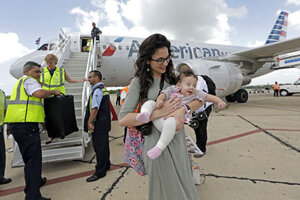Why American Airlines is trimming the number of flights to Cuba
With supply outpacing demand, American Airlines is cutting flights to several cities, while leaving four daily routes to Havana in place. Political uncertainty and limited infrastructure may be deterring some Americans from visiting the island.

Miriam Turner arrives with her baby Chana, 7 months, in Cienfuegos, Cuba, on her way to visit the Jewish community in Cuba on American Airlines inaugural scheduled service from Miami to Cuba on Wednesday, Sept.7, 2016. American Airlines is cutting one of each of its two daily services between Miami and the Cuban cities of Holguin, Santa Clara and Varadero.
Al Diaz/Miami Herald/AP/Files
Though lower-than-expected demand has led American Airlines to trim three flights to Cuba, political stability and infrastructure investments could attract more Americans to the island in the long term.
In a week that has seen several airlines — including American — make their first commercial trips to Havana, American Airlines said that it will cut back on some flights to Cuba. It currently operates two flights daily between Miami and each of the Cuban cities Holguin, Santa Clara, and Varadero. This twice-daily service will be cut to once daily.
With 12 US airlines licensed to travel to Havana, American Airlines may find that reducing service to smaller cities in favor of flights to the Cuban capital will help them remain financially competitive. But travel to the island looks set to rise longer term, if political restrictions are further loosened and Cuba improves its tourist facilities.
Europeans, Canadians, and others have been visiting Cuba for decades. Until recently, however, Americans were barred from traveling to the island under a US trade embargo — and could face fines if they did so. In January 2015, the US government established 12 categories of permitted travel to Cuba, and several rounds of loosened restrictions allowed for commercial airlines to re-establish service to the country.
For the first time, Americans found themselves able to visit a near neighbor that had long been shrouded in mystery. Tourism increased by 17.4 percent, hitting a record 3.52 million visitors in 2015. Besides hundreds of thousands of Cuban-Americans, who are able to travel and visit family, 161,000 Americans made a trip to Cuba in 2015.
“Given that our travelers are older and grew up during the Castro era, they’re extremely curious about Cuba and hopeful to experience it,” Priscilla L. O’Reilly, a spokeswoman for Overseas Adventure Travel told The New York Times.
But with 110 daily flights to Cuba planned for the near future (according to White House press secretary Josh Earnest), supply may be outpacing demand. Prices remain low, and there are still empty seats on numerous flights.
Why are more Americans not traveling to the island? Limited infrastructure may provide part of the answer. Reuters reported in January that the country has just 63,000 hotel rooms and a relatively limited number of rental cars. Some visitors had been sleeping in parks, while bottlenecks at the aging Havana airport cause frustrations.
“I don’t think Cuba is prepared,” Gisela Hoiman of Berlin told Reuters.
The masses of tourists may also act as a deterrent for Americans who had hoped to beat the crowds and get a sense of “authentic” Cuban life.
“Cuba is over the top with tourists,” said Ana Fernandez of Nashville, Tenn. to Reuters.
Some Americans may be waiting for new tourism development to come: Cuba has announced infrastructure projects to increase the number of hotel rooms to 85,000 by 2020, and is seeking foreign investment. Other potential visitors appear to be waiting for greater openness, such as the ability to go on a beach vacation, which is not covered in the 12 categories of permissible visits issued by the US government.
There are also questions about political stability. President-elect Donald Trump has indicated that he may close off relations with Cuba once again, leaving some people uncertain about whether they will actually be able to take trips they have planned.
But Cuba watchers have suggested that the linkages developed between the US and Cuba during the Obama administration may make current levels of openness irreversible. And tour operators are optimistic that the business advantages will persuade Mr. Trump to continue allowing tourism.
“We are hopeful that President-elect Trump’s extensive business and hospitality background will make him receptive to the value that travel can play in improving international relations,” Pamela Lassers, a spokeswoman for luxury travel firm Abercrombie & Kent, told The New York Times.

